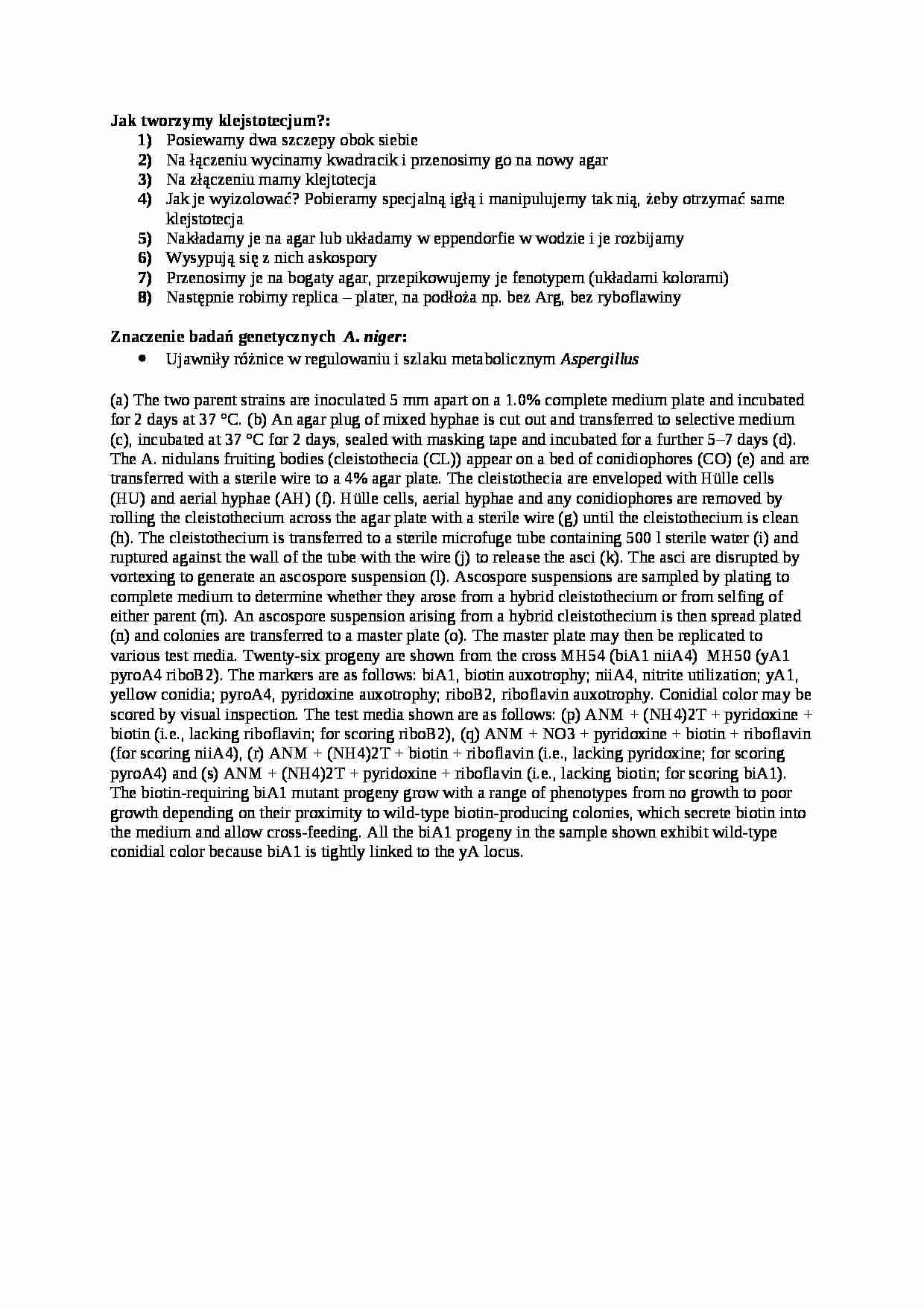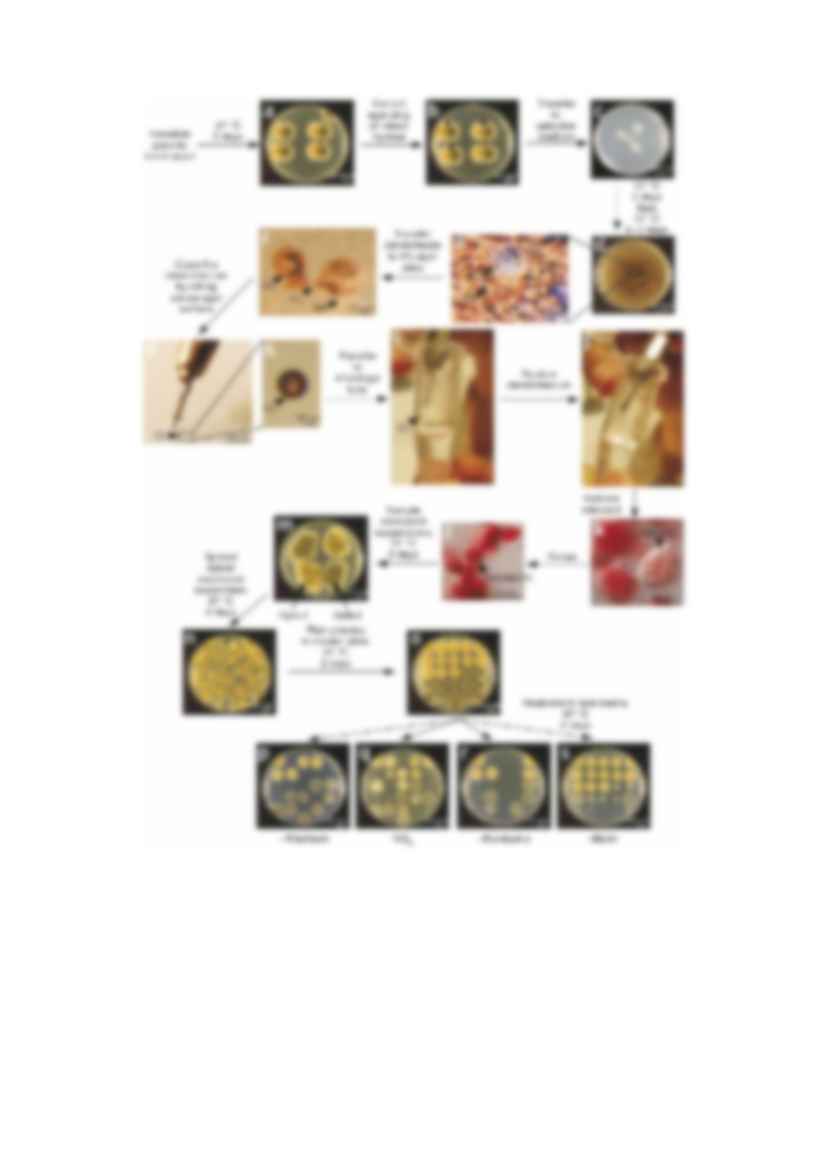To tylko jedna z 2 stron tej notatki. Zaloguj się aby zobaczyć ten dokument.
Zobacz
całą notatkę


Jak tworzymy klejstotecjum?:
Posiewamy dwa szczepy obok siebie
Na łączeniu wycinamy kwadracik i przenosimy go na nowy agar
Na złączeniu mamy klejtotecja
Jak je wyizolować? Pobieramy specjalną igłą i manipulujemy tak nią, żeby otrzymać same klejstotecja
Nakładamy je na agar lub układamy w eppendorfie w wodzie i je rozbijamy
Wysypują się z nich askospory
Przenosimy je na bogaty agar, przepikowujemy je fenotypem (układami kolorami)
Następnie robimy replica - plater, na podłoża np. bez Arg, bez ryboflawiny
Znaczenie badań genetycznych A. niger:
Ujawniły różnice w regulowaniu i szlaku metabolicznym Aspergillus
(a) The two parent strains are inoculated 5 mm apart on a 1.0% complete medium plate and incubated for 2 days at 37 °C. (b) An agar plug of mixed hyphae is cut out and transferred to selective medium (c), incubated at 37 °C for 2 days, sealed with masking tape and incubated for a further 5-7 days (d). The A. nidulans fruiting bodies (cleistothecia (CL)) appear on a bed of conidiophores (CO) (e) and are transferred with a sterile wire to a 4% agar plate. The cleistothecia are enveloped with Hülle cells (HU) and aerial hyphae (AH) (f). Hülle cells, aerial hyphae and any conidiophores are removed by rolling the cleistothecium across the agar plate with a sterile wire (g) until the cleistothecium is clean (h). The cleistothecium is transferred to a sterile microfuge tube containing 500 l sterile water (i) and ruptured against the wall of the tube with the wire (j) to release the asci (k). The asci are disrupted by vortexing to generate an ascospore suspension (l). Ascospore suspensions are sampled by plating to complete medium to determine whether they arose from a hybrid cleistothecium or from selfing of either parent (m). An ascospore suspension arising from a hybrid cleistothecium is then spread plated (n) and colonies are transferred to a master plate (o). The master plate may then be replicated to various test media. Twenty-six progeny are shown from the cross MH54 (biA1 niiA4) MH50 (yA1 pyroA4 riboB2). The markers are as follows: biA1, biotin auxotrophy; niiA4, nitrite utilization; yA1, yellow conidia; pyroA4, pyridoxine auxotrophy; riboB2, riboflavin auxotrophy. Conidial color may be scored by visual inspection. The test media shown are as follows: (p) ANM + (NH4)2T + pyridoxine + biotin (i.e., lacking riboflavin; for scoring riboB2), (q) ANM + NO3 + pyridoxine + biotin + riboflavin (for scoring niiA4), (r) ANM + (NH4)2T + biotin + riboflavin (i.e., lacking pyridoxine; for scoring pyroA4) and (s) ANM + (NH4)2T + pyridoxine + riboflavin (i.e., lacking biotin; for scoring biA1). The biotin-requiring biA1 mutant progeny grow with a range of phenotypes from no growth to poor growth depending on their proximity to wild-type biotin-producing colonies, which secrete biotin into the medium and allow cross-feeding. All the biA1 progeny in the sample shown exhibit wild-type conidial color because biA1 is tightly linked to the yA locus.
... zobacz całą notatkę




Komentarze użytkowników (0)